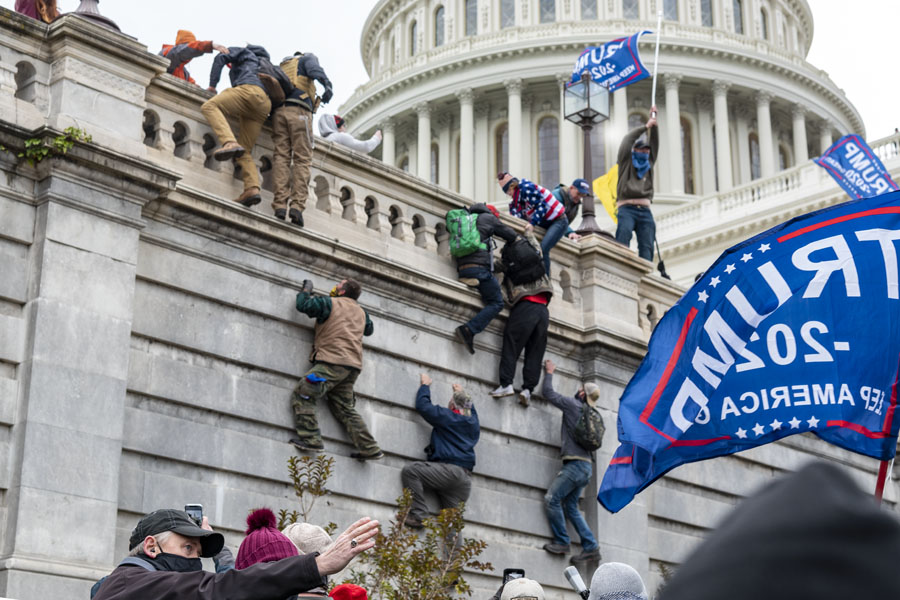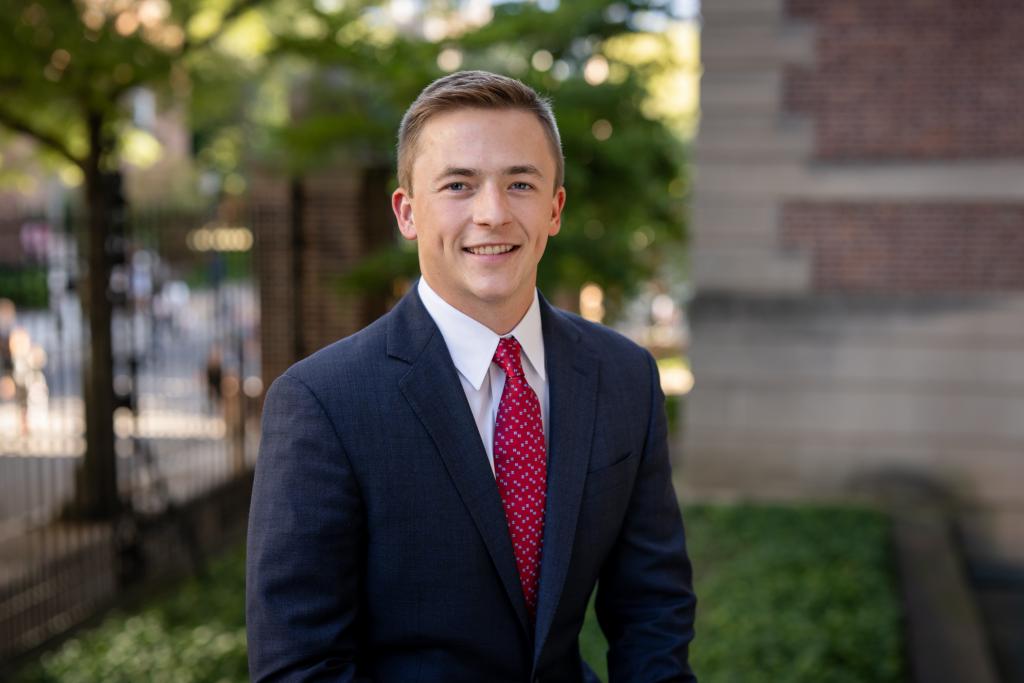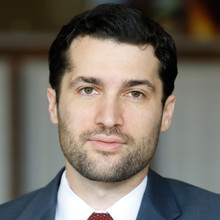Presidential Immunity, the First Amendment and the Capitol Riot
In their motions to dismiss Rep. Bennie Thompson’s suit, Trump, Giulani and the Oath Keepers defend their conduct on Jan. 6.

Published by The Lawfare Institute
in Cooperation With

In February, Rep. Bennie Thompson, chairman of the House Committee on Homeland Security, sued President Donald Trump, his lawyer Rudy Giuliani, and the far-right extremist group the Oath Keepers, among others, for damages arising from the Jan. 6 Capitol insurrection. The lawsuit, brought by the NAACP and soon joined by 10 other members of Congress who were present in the Capitol that day, alleged violations of 42 U.S.C. § 1985(1), a Reconstruction-era statute creating civil liability for conspiracies that prevent public officials from “holding any office” or “discharging any duties.”
Last week Trump, Giuliani and the Oath Keepers filed their motions to dismiss. The defendants raise a variety of arguments in the motions, some of which are peripheral, speculative or simply incoherent. But the core of the defenses for Trump and Giuliani—that the pair were exercising their First Amendment rights in their statements up to and during Jan. 6, and that Trump has absolute immunity for official actions taken during his presidency—are formidable. The lawsuit will likely continue in some form, but it’s certainly possible that Thompson v. Trump will become Thompson v. Oath Keepers before long.
Presidential Immunity
As one of us argued when the lawsuit was first brought, Trump’s strongest argument is that he enjoys absolute civil immunity for actions taken in his official capacity as president. As the Supreme Court explained in Nixon v. Fitzgerald—and as Trump’s brief emphasizes—former presidents are entitled to “absolute Presidential immunity from damages liability for acts within the ‘outer perimeter’ of [their] official responsibility.” The importance of immunity for official acts of the president, and executive branch officials, is further reflected in the Westfall Act, a statutory tort immunity for federal employees, which Trump argues also bars the suit on the grounds that the “allegations arose out of his allegations of political speech, clearly within the scope of his employment.”
Presidential immunity is not unbounded. In Clinton v. Jones, another case that Trump cites, the Supreme Court permitted a lawsuit against a sitting president for “purely private acts” taken largely before President Clinton assumed office. The question, then, is—assuming that Jones could be extended to actions taken taken wholly during a president’s stay in office—whether Trump’s repeated lies about the 2020 election and his inflammatory rhetoric at the “Stop the Steal” rally were within the “outer perimeter” of his office. In other words, the court might have to decide if the “outer perimeter” encompasses remarks that included “If you don’t fight like hell you’re not going to have a country anymore” and “We will never give up, we will never concede.”
There is no straightforward test for the boundaries of presidential immunity under Fitzgerald. Rather, the Supreme Court has applied a “functional approach” that stresses the diversity of the president’s duties and responsibilities and the need to preserve as much latitude as possible for the president’s functioning. As the Supreme Court wrote in Fitzgerald, “Cognizance of this personal vulnerability frequently could distract a President from his public duties, to the detriment of not only the President and his office but also the Nation that the Presidency was designed to serve.” Thus, even illegal actions do not necessarily fall outside the realm of “official duties.”
Here, Trump’s brief invokes the recent history of election challenges by federal officials to argue that “[p]ost-election challenges are not unusual.” In a lengthy introduction, Trump points to several instances of Democratic politicians challenging the validity of elections. Of course, these comparisons miss important context—most obviously, the scope and severity of Trump’s attacks on the democratic process and the political disturbance that it caused.
But here Trump’s tendency to believe his own lies may paradoxically strengthen his argument, as it did during his first impeachment: By many accounts Trump really did (and still does) believe that the election was stolen. Delusional and baseless as that belief was (and is), Trump appears to have been sincere in believing that questioning the election was necessary to “preserve, protect and defend the Constitution of the United States.” In his motion, Trump explicitly argues that “the President questioning whether election procedures comported with the Constitution and holding a rally for those who also were concerned with fair process—are in fact Presidential duties as the Constitution requires that the President ‘preserve, protect, and defend the Constitution of the United States’... and take ‘Care that the Laws be faithfully executed[.]’” Trump’s understanding of his constitutional obligations was a perversion of those very obligations—which was the core of both of his impeachments—but behavior grounded in a perverse understanding of an official duty may still remain an official duty.
The First Amendment
Even if Trump’s immunity argument fails, his motion to dismiss makes a colorable argument that his rhetoric, however reprehensible, was constitutionally protected speech. And for Giuliani, who as a private citizen cannot claim immunity, the First Amendment is his strongest defense.
As with all cases involving speech that leads to violence, the key case here is Brandenburg v. Ohio: “The constitutional guarantees of free speech and free press do not permit a State to forbid or proscribe advocacy of the use of force or of law violation except where such advocacy is directed to inciting or producing imminent lawless action and is likely to incite or produce such action” (emphasis added). “Imminence” is a vague term, but the substantial case law devoted to its elaboration has made clear that there is a high bar for punishing speech on the grounds that it leads to violence.
The Brandenburg test applies to civil cases as well. For example, Trump cites NAACP v. Claiborne Hardware Co. (an ironic detail, given the NAACP’s leading role in bringing this lawsuit), in which the Supreme Court unanimously overturned a Mississippi Supreme Court decision finding an NAACP that boycotted businesses in Claiborne, Mississippi, liable for lost business. Although the field secretary of the NAACP chapter, Charles Evers (who, in another twist, endorsed Trump 50 years later) reportedly told a large gathering, “If we catch any of you going in any of them racist stores, we’re gonna break your damn neck,” the Supreme Court recognized that the speech was protected under Brandenburg because “[a]n advocate must be free to stimulate his audience with spontaneous and emotional appeals for unity and action in a common cause.” Trump cites the case to underscore the Supreme Court’s position that speech on issues of public matters sits at the “highest rung of the hierarchy of First Amendment values.”
Of course, there are important differences between the facts of Brandenburg and Claiborne on the one hand and those of Jan. 6 on the other. Most importantly, in neither Brandenburg nor Claiborne Hardware did violence immediately following the speech at issue; on Jan. 6 it did. Indeed, as the court made clear in Claiborne Hardware, “[i]f that language had been followed by acts of violence, a substantial question would be presented whether Evers could be held liable for the consequences of that unlawful conduct.” By contrast, Trump ended his Jan. 6 speech around 1:10 p.m., telling his supporters, “We’re going to the Capitol,” and his supporters had broken windows to enter the Capitol at 2:30 p.m.
Ultimately, determining whether a causal connection exists between Trump’s and Giuliani’s speech and the Capitol riot will depend on a careful examination of both the speech and the larger context. Here both sides have plausible arguments. Trump and Giuliani argue in their motions that the majority of their rhetoric was peaceful; Trump, for example, points to his encouragement to the crowd to “peacefully and patriotically make your voices heard.” And Giuliani also argues that even his most inflammatory rhetoric was, all things considered, mild. His motion describes his now-infamous call to “trial by combat” as “clearly hyperbolic and not literal[.]” In truth, from Giuliani it does seem like just one more example of his trademark over-the-top, octogenarian puffery.
But however Trump and Giuliani try to spin their participation in the Jan. 6 rally, this was not the case of some isolated rabble-rousers ranting on a street corner. The president of the United States and his chief lawyer—himself a world-famous public figure and one-time leading presidential candidate—used flagrant lies to rile up hundreds of people, many of them armed members of extremist militias, to march down to the Capitol and express their displeasure at the peaceful transition of power. Since Jan. 6, some rioters, including the “QAnon Shaman,” have even argued in separate criminal proceedings that they would not have stormed the Capitol “but for the specific words of the then-President.” As one Capitol rioter’s defense lawyer said in court, “The president of the United States of America was telling citizens something evil has happened and you all have to go fix it.”
Trump points to the unique features of the situation as a reason to extend even stronger First Amendment protections to their speech. As one of the cases that Trump cites makes clear, “political speech is entitled to the fullest possible measure of constitutional protection.” And public figures, and the president in particular, can plausibly argue that courts should be particularly careful not to chill their speech, in part because of the same separation-of-powers concern that underlies presidential immunity and in part because of the unique role that presidential communication plays in American democracy.
There’s no obvious answer to the First Amendment arguments in this case, not least because of the profoundly unprecedented nature of what occurred on Jan. 6. The court may be able to avoid a difficult First Amendment analysis in Trump’s case if it finds that the lawsuit must be dismissed on presidential immunity grounds. But since immunity is not an option for Giuliani, the court will likely have to engage with the First Amendment at least with respect to him.
Statutory Elements
Constitutional issues aside, Thompson’s suit raises standard issues of statutory interpretation and civil procedure. Here Trump, Giuliani and the Oath Keepers make a wide variety of arguments. Some of these are fairly technical—Trump, for example, argues that members of Congress can’t sue under § 1985 because, as elected representatives, they are neither “officers under the United States” nor do they “hold office under the United States.” And the Oath Keepers argue that members of Congress can’t sue under § 1985 because the Constitution provides that Electoral College votes are to be counted and certified “in the Presence of the Senate and House of Representatives,” and thus the power at issue is an institutional one held by the two houses of Congress, not by any individual congressperson.
But the core statutory claim that all three defendants make is simply that the conspiracy that § 1985 prohibits has not been adequately pleaded. The first requirement of any civil plaintiff is to provide a “short and plain statement of the claim showing that the pleader is entitled to relief.” Importantly, it is not enough simply to assert facts that would give rise to a cause of action; the plaintiff’s allegation must be “facially plausible” in that it “pleads factual content that allows the court to draw the reasonable inference that the defendant is liable for the misconduct alleged.” And the more particular the facts the plaintiff alleges, the more likely it is that the complaint will satisfy a motion to dismiss.
As one of us has previously explained, the question of whether Trump and Giuliani in particular conspired to incite a riot against the Capitol is a difficult one:
[C]onspiracy defendants “must have a shared objective” and “[t]he defendant held liable as part of the conspiracy must have intended to bring about the tortious wrong that was the subject of the agreement.” Here, the tort is to “to prevent, by force, intimidation, or threat” one of the § 1985 predicates. Based on the planning alleged in the complaint, this should be relatively straightforward to establish in the case of the Oath Keepers and the Proud Boys, two of the named defendants. Establishing this as to Giuliani (or Trump, assuming his immunity claim fails) will be more difficult, as their degree of coordination with the Oath Keepers and Proud Boys remains unknown.
The test for whether a complaint alleges sufficient facts to plausibly establish a claim is notoriously vague—or, as the Supreme Court has euphemistically explained, is “context-specific, requiring the reviewing court to draw on its experience and common sense.” The evidence is likely sufficient to satisfy pleading standards for the Oath Keepers, given the voluminous physical and digital evidence of that group’s involvement in coordinating many of the events of Jan. 6. But a judge could legitimately conclude either way as to the claims against Trump and Giuliani. Of course, if Trump’s immunity and Trump’s and Giuliani’s First Amendment claims are accepted, that will render the statutory issues moot.
***
Thompson’s lawsuit is far from dead in the water, but, at least with respect to Trump and Giuliani, it faces formidable constitutional and perhaps statutory challenges. And if Thompson is unsuccessful, his legal failure will underscore an important point: Across a number of constitutional, statutory, and procedural doctrines, the U.S. legal system is not well placed to deal with presidential attacks on American democracy. If accountability for Trump and his enablers is to be had, the nation’s political elites, and the voters who support them, will have to play the leading role.






